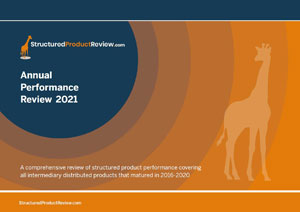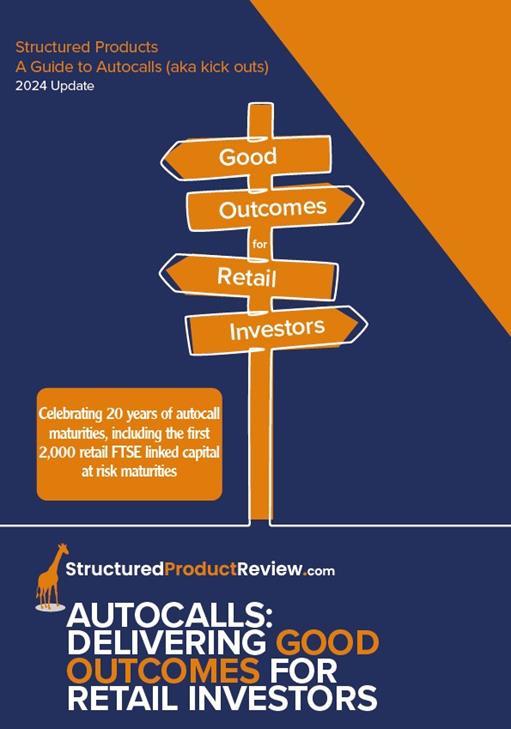We are looking for some feedback on the suitability reports / investment descriptions we generate for Lowes ‘Preferred’ products.
Could you provide any criticism, or feedback to help us improve?
Are our descriptions of use to you? Would you like then in Microsoft Word format?
A copy of our suitability report investment description for the latest 10:10 Plan can be found below.
Please contact me at Josh.Mayne@StructuredProductReview.com if you have any feedback, suggestions or would like us to provide you with a version of this and future issues in MS Word format for your own use.
Mariana 10:10 Plan October 2021 (Option 2)
This maximum ten-year investment offers the potential for a simple gain of 8.75% for each year held, depending on the performance of the FTSE Custom 100 Synthetic 3.5% Fixed Dividend Index (FTSE CSDI). The FTSE CSDI was specifically designed for structured products and is expected to closely replicate the performance of the FTSE 100 Index. Please see below for further detail.
The terms of the Plan provide protection to the invested capital against all but a severely underperforming stockmarket over the investment term, or the counterparty’s failure. Whilst the Plan is designed as a maximum ten-year investment, it will mature early on any of its anniversaries from year two onwards, provided the FTSE CSDI closes at a level at least equal to that recorded at commencement. Briefly, the Plan is structured to provide the following returns:
The Plan is designed to return the invested capital in full, in addition to an 8.75% gain for each year held if, on any of its anniversary dates from year two onwards, the FTSE CSDI closes at, or above, the closing value recorded on 29th October 2021 (the Initial Index Level).
Therefore, if on 30th October 2023 the index closes at a level at least equal to the Initial Index Level, the Plan will mature returning the invested capital, plus a gain of 17.5%. If the Plan does not mature on this date, it will then continue onto year three. Once again, if the index closes at a level at least equal to the Initial Index Level on the third anniversary date, the Plan will mature and return the original capital investment in full, in addition to a 26.25% gain. Otherwise, the Plan will continue onto year four, etc., through to year ten.
If the Plan reaches its final maturity date because on each of the previous eight anniversary dates the index closed below the Initial Index Level, then the maturity value will be dependent upon the closing level of the FTSE CSDI on 29th October 2031 (the Final Index Level).
If the Final Index Level is at, or above, its initial level, then the invested capital should be returned in full, in addition to an 87.5% gain (i.e. 8.75% gain multiplied by ten years).
If the Final Index Level is below its Initial Index Level, no gain will be returned; however, investors' capital should still be returned in full, unless the Final Index Level is more than 30% below the Initial Index Level. If such a fall does occur, investors will suffer a reduction to their invested capital of 1% for every 1% the Final Index Level is below the Initial Index Level. For example, if the index finishes 35% lower, only 65% of the original capital will be returned.
The returns outlined above, including the return of capital are dependent upon Morgan Stanley & Co. International plc, the counterparty to the investment, meeting their contractual obligations on time, as investors will in effect be lending their capital to them.
Morgan Stanley & Co. International plc has a Standard & Poor’s rating of ‘A+’ indicating that they believe it has a strong capacity to meet financial commitments. Regardless of the perceived strength of a counterparty, it must be appreciated that if Morgan Stanley & Co. International plc is unable to meet its liabilities or, is declared bankrupt, investors could lose some or all of their capital regardless of the performance of the index.
Under the terms of this Plan, in order for there to be a reduction to the invested capital, it would require Morgan Stanley & Co. International plc to default or the Plan’s early maturity feature trigger to be missed on each of the eight observed anniversary dates and the FTSE CSDI to close on 29th October 2031 at a level more than 30% below its Initial Index Level. In the latter event, the loss to the invested capital would be at the same level as the fall in the index.
The Plan literature states that under current legislation any gain produced by this investment when held outside of a tax shelter will be subject to Capital Gains Tax rules, which may prove favourable as every individual has an annual capital gains exemption (£12,300 for the 2021/2022 tax year). Any gains that fall outside of the annual exemption in the year of maturity will be subject to tax at the prevailing rate which is currently 10% for basic rate taxpayers and 20% for higher rate taxpayers.
This investment is designed in such a way that it may have to be held for the full ten years and if it is encashed during the term (other than as the result of the early maturity feature), investors’ capital may not be returned in full, even if the index has risen.
Like most investments, this Plan is only suitable for those who are prepared to expose their capital to a degree of risk and accept the consequences of these risks resulting in the worst outcome. It is important that would-be investors read the Plan literature which gives full details of the contract including details of the risks, to which they should pay particular attention.
About the FTSE Custom 100 Synthetic 3.5% Fixed Dividend Index (FTSE CSDI)
The CSDI Index was created specifically for structured products by FTSE Russell, the same organisation that calculates and publishes the FTSE 100 Index. The CSDI tracks the same 100 shares but unlike the FTSE 100, the CSDI includes the benefit of the dividends paid by the 100 companies (which have historically averaged around 3.5% per annum) and then deducts the equivalent to a fixed 3.5% dividend per annum, on a daily basis. The result is that the index will perform almost identically to the FTSE 100 if dividends are at 3.5% pa, moderately underperform if they are less, and moderately overperform if they are more. In return for the structured product investor accepting the risk of variability of dividends, the counterparty bank does not have to. At times like now, counterparties are erring on the side of caution when estimating future dividend yields, with the cost of their caution reflected in the potential return they are prepared to offer on FTSE 100 linked structured products, compared to those linked to the CSDI.
The net result is that the returns that can currently be offered on structured products are enhanced by using the CSDI which is around 98% correlated with the FTSE 100 index. We consulted at length over the introduction of the CSDI and have no hesitation in endorsing its use as an alternative underlying index for autocall structured products.
For more information on the FTSE CSDI, please refer to the product literature. A link to the current price of the Index can be accessed via www.Lowes.co.uk/CSDI . You can monitor your structured products linked to this or any other index through our SP-Perspective.com service. If you have not yet registered account, please contact us.
Lowes has provided input into the concept, development, promotion and distribution of this Plan. The provider’s charges/fees are built into the terms of the investment - Lowes has a commercial interest in the Plan as a result of its involvement in its development and promotion. All Plan returns are stated after allowing for the provider’s charges/fees. Where Lowes is involved in advice on or the intermediation of this investment to retail clients, it will not receive any payment from Mariana for its input but instead, equivalent funds will be redirected to UK-registered charities at the direction of the Lowes Charity Committee, the annual report for which is available on request.
Also in this section
- How old is too old? Are structured products to die for?
- Product focus - October 2024
- Q3 2024 Issuance
- Q3 2024 maturity results
- A share of spread bets on steroids?
- Product focus - September 2024
- Maturities of the month - August 2024
- Right on time
- Product focus - August 2024
- Keep calm and zoom out
- 2,000 and counting
- Q2 2024 maturity results
- 20 years of autocall maturities
- Product focus - June 2024
- Fixed income or interest?
- Maturities of the month - May 2024
- The barrier debate - revisited
- Product focus - April 2024
- Maturities of the month - April 2024
- Time to call
- I don't believe markets are ever too high for Structured products!
- Notes on counterparty exposure
- Return of Nikkei
- Q1 2024 issuance
- Q1 2024 maturity results
- Structured Products – AAAAAGH!
- Hop in CIBC
- Re-enter Santander
- How to build a financial fortune - revisited
- Issuance in 2023
- Where's the risk?
- Questionable offerings
- Challenging the case against structured products - 'Loss of dividends'
- Navigating the investment landscape
- Challenging the case against structured products - Counterparty risk
- 6-year autocalls approaching final destination
- 1,750 FTSE capital at risk autocall maturities
- The leopard that changed her spots
- Q3 2023
- Challenging the case against structured products - Keydata
- Dilemmas for UK IFA's and the unique role of Structured Products
- 'High charges'
- Precipice bonds
- Intro
- FTSE 100 Contingent Income
- Indexing the indices
- Something different
- Investing through volatility
- 100 10:10s
- The best or worst?
- The 10%/25% 'Rule' that never was
- Structured products and the yield curve
- Fixed income: Capital at risk?
- Prospects for UK inflation - and fun with A.I!
- The Barrier Debate
- More Deposits for now
- Last of the Americans
- What if?
- Time heals all wounds, we hope...
- How to diversify portfolios using structured products?
- The Proof Is In The Pudding...
- Debunking Structured Misconceptions
- 1,500 FTSE Capital-at-Risk Autocall Maturities
- Q3 2022 Maturity Results
- What do we prefer?
- Deposits vs Capital ‘Protected’
- There’s time yet…
- Where did you invest your clients?
- A Six-Month Reflection
- Return of the Rev Con
- Happy 2nd Birthday FTSE CSDI
- Q2 2022 Maturity Results
- The best and worst yet still the best
- Critique my Suitability - Mariana 10:10 Plan June 2022 (Option 2)
- 10/10 for 55 10:10’s
- Q1 2022 Maturity Results
- 'How to build a financial fortune': a follow up
- Critique my Suitability - Mariana 10:10 Plan April 2022 (Option 2)
- 2021 Capital-at-Risk Autocall Maturity Review
- An unwelcome return...
- CSDI's First Birthday
- Bon Anniversaire
- Introducing the FTSE Custom 100 Synthetic 3.5% Fixed Dividend Index
- Q3 2021 Maturity Results
- Critique my Suitability - Mariana 10:10 Plan October 2021 (Option 2)
- Blurring the lines...
- Beware of false knowledge; it is more dangerous than ignorance
- Good news, bad news...
- Certainty is Certainly a Benefit
- Critique my Suitability - Mariana 10:10 Plan September 2021 (Option 2)
- A Twenty-Year Progression
- Q2 2021 Maturity Results
- Nine 8:8s Post Positive Returns in Falling Markets
- Critique my Suitability
- Q1 2021 Maturity Results
- Morgan Stanley’s Marvelous Maturity Medley
Current Products
We review the UK's retail structured investment sector, providing pertinent support for Professional Advisers and relevant research tools.
View all ⟶


